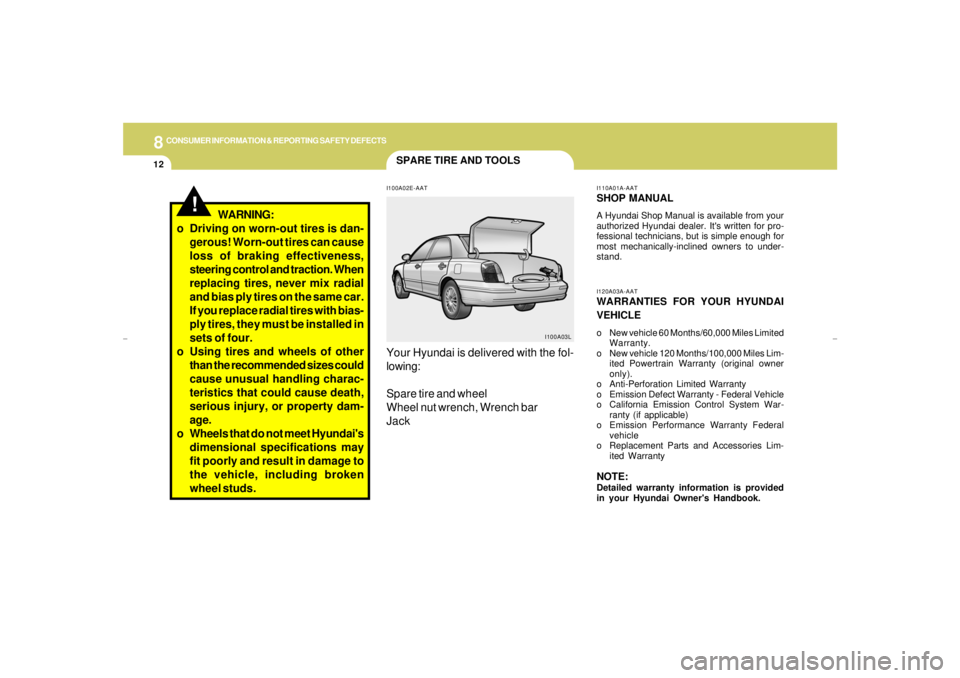2005 HYUNDAI XG350 wheel size
[x] Cancel search: wheel sizePage 226 of 247

8
CONSUMER INFORMATION & REPORTING SAFETY DEFECTS6
1. Manufacturer or Brand name
o Manufacturer or Brand name is
shown.
2. Tire size (example: P205/60R 16
94H)
o The "P" indicates the tire is de-
signed for passenger vehicles. A
"T" is the designation for a tempo-
rary spare tire. (If installed)
o Three-digit number (205): This num-
ber gives the width in millimeters
of the tire from sidewall edge to
sidewall edge.
o Two-digit number (60): This num-
ber, known as the aspect ratio,
gives the tire's ratio of height to
width.
o R: The "R" stands for radial.
o Two-digit number (16): This number
is the wheel or rim diameter in inches.
o Two (or three) digit number (94):
This number is the tire's load in-
dex. It is a measurement of how
much weight each tire can sup-
port.o H: Speed Rating. The speed rating
denotes the speed at which a tire is
designed to be driven for extended
periods of time. The ratings range
from "A" to "Z" (98 to 186 MPH).
3. TIN (Tire Identification Number) for
new tire (example: DOT XX XX XXX
XXXX)
o DOT: Abbreviation for the "Depart-
ment of Transportation". The sym-
bol can be placed above, below or
to the left or right of the Tire Iden
tification Number. Indicates tire is
in compliance with the U.S. De-
partment of Transportation Motor
Vehicle Safety Standards.
o 1st two-digit code: Manufacturer's
identification mark
o 2nd two-digit code: Tire size
o 3rd three-digit code: Tire type code
(Optional)
o 4th four-digit code: Date of Manu-
facture
Federal law requires tire manufacturers
to place standardized information on
the sidewall of all tires. This information
identifies and describes the fundamen-
tal characteristics of the tire and also
provides the tire identification number
(TIN) for safety standard certification.
The TIN can be used to identify the tire
in case of a recall.I030B01L-AATTIRE SIDEWALL LABELING
I030B04JM
1
234 5, 6
7
1
xgflhma-8.p656/16/04, 2:57 PM 6
Page 229 of 247

8
CONSUMER INFORMATION & REPORTING SAFETY DEFECTS
9
Sidewall: The portion of a tire between
the tread and the bead.
Speed Rating: An alphanumeric code
assigned to a tire indicating the maxi-
mum speed at which a tire can operate.
Traction: The friction between the tire
and the road surface. The amount of
grip provided.
Tread: The portion of a tire that comes
into contact with the road.
Treadwear Indicators: Narrow bands,
sometimes called "wear bars," that show
across the tread of a tire when only 2/32
inch of tread remains.
UTQGS: Uniform Tire Quality Grading
Standards, a tire information system
that provides consumers with ratings
for a tire's traction, temperature and
treadwear. Ratings are determined by
tire manufacturers using government
testing procedures. The ratings are
molded into the sidewall of the tire.Vehicle Capacity Weight: The number
of designated seating positions multi-
plied by 150 lbs. (68 kg) plus the rated
cargo and luggage load
Vehicle Maximum Load on the Tire:
Load on an individual tire due to curb
and accessory weight plus maximum
occupant and cargo weight.
Vehicle Normal Load on the Tire:
That load on an individual tire that is
determined by distributing to each axle
its share of the carb weight, accessory
weight, and normal occupant weight
and driving by 2.
Vehicle Placard: A label permanently
attached to a vehicle showing the origi-
nal equipment tire size and recom-
mended inflation pressure
I040B01JM-AATALL SEASON TIRES
Hyundai specifies all season tires on
some models to provide good perfor-
mance for use all year round, including
snowy and icy road conditions. All sea-
son tires are identified by ALL SEASON
and/or M+S (Mud and Snow) on the tire
sidewall. Snow tires have better snow
traction than all season tires an may be
more appropriate in some areas.I040C01JM-AATSUMMER TIRES
Hyundai specifies summer tires on some
models to provide superior performance
on dry roads. Summer tire performance
is substantrally reduced in snow and ice.
Summer tires do not have the tire trac-
tion rating M+S (Mud and Snow) on the
tire side wall. if you plan to operate your
vehicle in snowy or icy conditions.
Hyundai recommends the use of snow
tires or all season tires on all four wheels.
xgflhma-8.p656/16/04, 2:57 PM 9
Page 230 of 247

8
CONSUMER INFORMATION & REPORTING SAFETY DEFECTS
10
!
I050A02Y-AATTIRE CHAINS
Tire chains, if necessary, should be
installed on the front wheels. Be sure
that the chains are installed in accor-
dance with the manufacturer's instruc-
tions.
To minimize tire and chain wear, do not
continue to use tire chains when they
are no longer needed.
WARNING:
When driving on roads covered with
snow or ice, drive at less than 20
mph (30 km/h).
I060A02A-AATTIRE ROTATION
Tires should be rotated every 7,500
miles (12,000 km). If you notice that
tires are wearing unevenly between ro-
tations, have the car checked by a
Hyundai dealer so the cause may be
corrected.
After rotating, adjust the tire pressures
and be sure to check the wheel nut
torque.
HEF-241 I040A01S-AAT
SNOW TIRES
If you equip your car with snow tires,
they should be the same size and have
the same load capacity as the original
tires. Snow tires should be installed on
all four wheels; otherwise, poor han-
dling may result.
Snow tires should carry 4 psi (28 kPa)
more air pressure than the pressure
recommended for the standard tires on
the tire label on the driver's door edge ,
or up to the maximum pressure shown
on the tire sidewall whichever is less.
Do not drive faster than 75 mph (120
km/h) when your car is equipped with
snow tires.
xgflhma-8.p656/16/04, 2:57 PM 10
Page 231 of 247

8
CONSUMER INFORMATION & REPORTING SAFETY DEFECTS
11
I090A01A-AATWHEN TO REPLACE TIRES
The original tires on your car have tread
wear indicators. The tread wear indica-
tors appear when the tread depth is 0.06
in. (1.6 mm). The tire should be re-
placed when these appear as a solid bar
across two or more grooves of the
tread. Always replace your tires with
those of the recommended size. If you
change wheels, the new wheel's rim
width and offset must meet
Hyundai specification.
HGK248
0.06 in. (1.6 mm)
Wear indicator
I080A01A-AATTIRE TRACTION
Tire traction can be reduced if you drive
on worn tires, tires that are improperly
inflated or on slippery road surfaces.
Tires should be replaced when tread
wear indicators appear. To reduce the
possibility of losing control, slow down
whenever there is rain, snow or ice on
the road.I070A01A-AATTIRE BALANCING
A tire that is out of balance may affect
handling and tire wear. The tires on your
Hyundai were balanced before the car
was delivered but may need balancing
again during the years you own the car.
Whenever a tire is dismounted for re-
pair, it should be rebalanced before
being reinstalled
on the car.
!
WARNING:
o Do not use the temporary spare
tire for tire rotation.
o Do not mix bias ply and radial ply
tires under any circumstances.
This may cause unusual handling
characteristics that could result in
death, serious injury, or property
damage.
xgflhma-8.p656/16/04, 2:57 PM 11
Page 232 of 247

8
CONSUMER INFORMATION & REPORTING SAFETY DEFECTS
12
SPARE TIRE AND TOOLSI100A02E-AATYour Hyundai is delivered with the fol-
lowing:
Spare tire and wheel
Wheel nut wrench, Wrench bar
Jack
I100A03LI110A01A-AAT
SHOP MANUALA Hyundai Shop Manual is available from your
authorized Hyundai dealer. It's written for pro-
fessional technicians, but is simple enough for
most mechanically-inclined owners to under-
stand.I120A03A-AATWARRANTIES FOR YOUR HYUNDAI
VEHICLEo New vehicle 60 Months/60,000 Miles Limited
Warranty.
o New vehicle 120 Months/100,000 Miles Lim-
ited Powertrain Warranty (original owner
only).
o Anti-Perforation Limited Warranty
o Emission Defect Warranty - Federal Vehicle
o California Emission Control System War-
ranty (if applicable)
o Emission Performance Warranty Federal
vehicle
o Replacement Parts and Accessories Lim-
ited WarrantyNOTE:Detailed warranty information is provided
in your Hyundai Owner's Handbook.
!
WARNING:
o Driving on worn-out tires is dan-
gerous! Worn-out tires can cause
loss of braking effectiveness,
steering control and traction. When
replacing tires, never mix radial
and bias ply tires on the same car.
If you replace radial tires with bias-
ply tires, they must be installed in
sets of four.
o Using tires and wheels of other
than the recommended sizes could
cause unusual handling charac-
teristics that could cause death,
serious injury, or property dam-
age.
o Wheels that do not meet Hyundai's
dimensional specifications may
fit poorly and result in damage to
the vehicle, including broken
wheel studs.
xgflhma-8.p656/16/04, 2:57 PM 12
Page 238 of 247

9
VEHICLE SPECIFICATIONS2
J060A01L-AATFUEL SYSTEM
J050A01L-GATBRAKEJ040A01L-AATELECTRICAL
J020A01L-AATPOWER STEERINGJ010A02L-AATMEASUREMENT
191.8 (4875)
70.86 (1800)
55.9 (1420)
108.2 (2750)
60.6 (1540)
60.23 (1530) Overall length
Overall width
Overall height
Wheel base
Wheel tread
Front
Rear
Type
Wheel free play
Rack stroke
Oil pump typeRack and pinion
0 ~ 1.18 in (0 ~ 30 mm.)
5.74 in (146 mm.)
Vane type
Battery
AlternatorMF 68AH (MF)
120A (13.5V)
Dual hydraulic with brake booster
Ventilated disc
Solid disc
Cable operated on rear wheel Type
Front brake type
Rear brake type
Parking brake
18.5 US.gal (15.4 Imp.gal, 70 Liter)
Fuel tank capacity
J030A03L-AATTIRE
Tire pressure
Tire
Standardpsi (kpa)
Size
P205/60 R16 94H in. (mm)
Front
Rear
33 (230)
30 (210)
xgflhma-9.p656/16/04, 2:56 PM 2